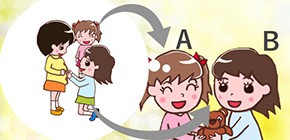
"A good deed is its own reward" scientifically demonstrated
A group of researchers led by SHIMIZU Mayuko ( Specially Appointed Researcher) and ONISHI Kenji (Assistant Professor, Graduate School of Humanities and Sciences, Osaka University) confirmed in a first that social indirect reciprocity, a system of exchanging kindness, worked in daily lives of 5- to 6-year-old children.
Bystander children tended to display prosocial behavior toward their peers more frequently after observing these peers’ prosocial behavior toward third-party peers. Thus, it was clarified that young children evaluated peers' kindness by observing the peers’ prosocial behavior toward third-party peers. Young children who are kind to peers tend be the recipients of kindness by other children.
When one is nice to others, one's reputation increases; thus, the prosocial behavior brings about a reward from others. This mechanism is called "social indirect reciprocity." Bystanders evaluate peers by observing the peers’ prosocial behavior toward third-party peers. What they found shows the truth in the old saying, "A good deed is its own reward."
Research pointed out the possibilities that social indirect reciprocity was established in the exchange of altruistic behavior. Using naturalistic observation at a nursery school, this group demonstrated for the first time that social indirect reciprocity works from an early stage in life.
Abstract
Social indirect reciprocity seems to be crucial in enabling large-scale cooperative networks among genetically unrelated individuals in humans. However, there are relatively few studies on social indirect reciprocity in children compared to adults. Investigating whether young children have a behavioral tendency toward social indirect reciprocity will help us understand how and when the fundamental ability to form cooperative relationships among adults is acquired. Using naturalistic observation at a nursery school, this study examined whether 5- to 6-year-olds show a behavioral tendency to engage in social indirect reciprocity in response to their peers’ prosocial behavior toward a third party. The results revealed that bystander children tended to display prosocial behavior toward their peers more frequently after observing these peers’ prosocial behavior toward third-party peers, compared with control situations; this suggests that 5- to 6-year-olds may have an essential behavioral tendency to establish social indirect reciprocity when interacting with peers in their daily lives. In addition, bystanders tended to display affiliative behavior after observing focal children’s prosocial behavior. In other words, observing peers’ prosocial behavior toward third-party peers evoked bystanders’ positive emotions toward the helpers. Considering both the present results and previous findings, we speculate that in preschoolers, such positive emotions might mediate the increase in the bystander’s prosocial behavior toward the helper. In addition, an intuitional emotional process plays an important role in the preschooler’s behavioral tendency toward social indirect reciprocity in natural interactions with peers.

Figure 1

Figure 2

Figure 3
To learn more about this research, please read the full research report entitled " Preschool children’s behavioral tendency toward social indirect reciprocity " at this page of the PLOS ONE website.
Related link :
